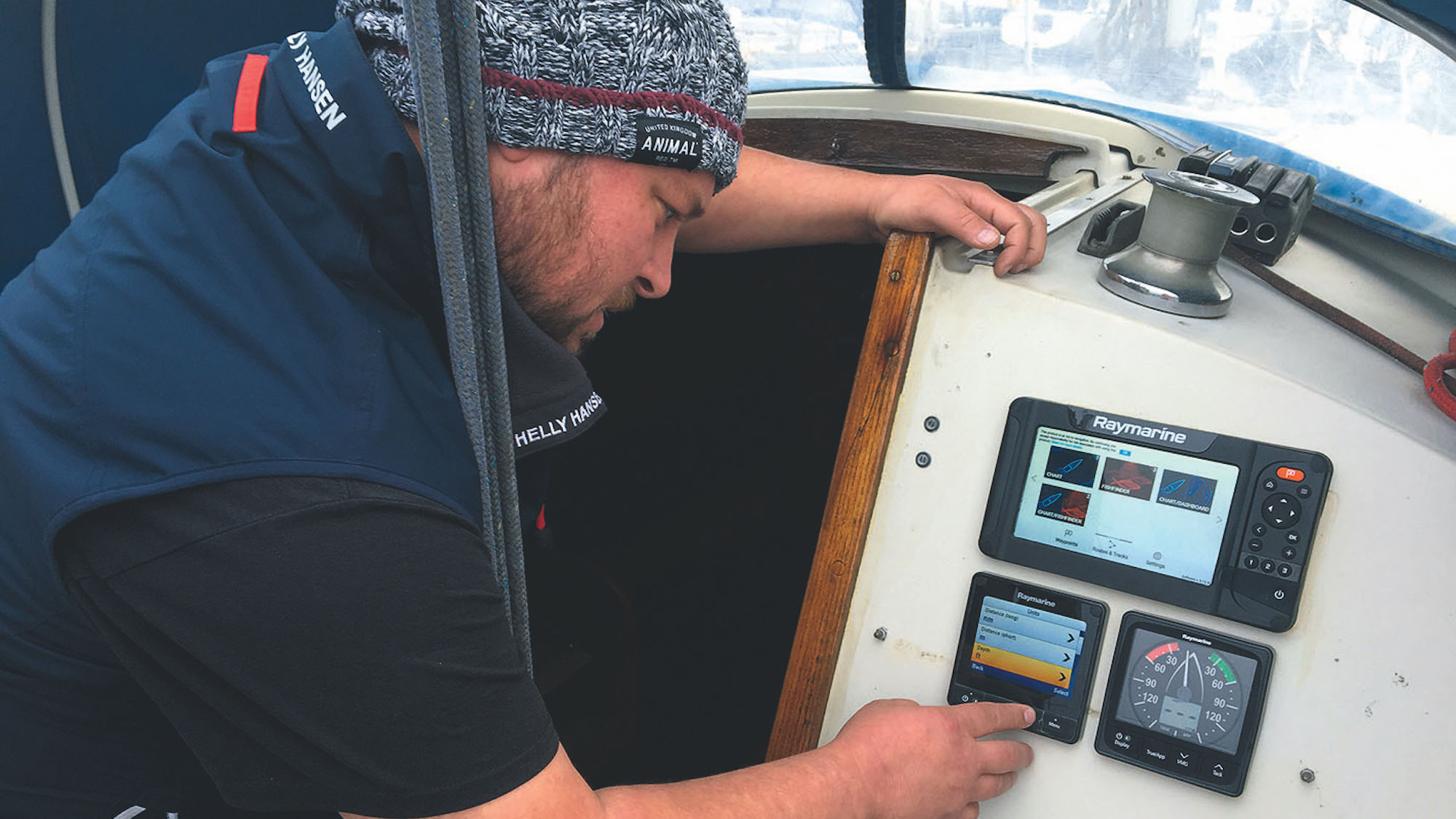Ali Wood gets a crash course in reverse polarity and smart charging when Project Boat Maximus’s shore power gets trippy
More than once while our Maxi 84 PBO Project Boat was kept in a marina last year, I arrived at the berth to find our battery voltage had dropped to 12.4V, despite having connected it to shore power.
Each time it would appear to have tripped – though never while I was on board.
When Adam McMenemy of ACM Marine next visited Maximus, I asked him to take a look.
We flicked the breaker back up on the RCD box and reconnected the shore power.
The charge jumped to 14.4V on the Victron smart meter, a sign that the battery was going into bulk charge, as all batteries will do when initially charged.

Each time I went back to the boat the shore power had tripped
We left it a while and moved onto other tasks we’d planned. Adam’s colleague, Ciaran Vernon, showed me how to check the battery’s charging history on the Victron Connect app on my smartphone.
This is where the Victron smart meter gets really clever (see panel over the page). I hadn’t had any problems at other berths, so one possibility was reverse polarity – where the live and neutral wires are reversed at the shore power connection.
That could explain why the battery initially started bulk charging, but once it dropped to float mode (around 13.5V) it would cut out, then naturally discharge over time.
Continues below…
How to service a marine diesel engine in 12 simple steps
It was time to service the marine diesel engine on our Maxi 84 cruiser. Knowing how to diagnose and fix…
Understanding electrics: insulating & signal wire connectors
Oliver Ballam and Pat Manley demystify boat electrics and explain various types of electrical connectors and their uses on board
New electronics on the PBO Project Boat
The day was approaching for Maximus’s shakedown cruise, a two-day voyage from Chichester to her new home at Cobbs Quay…
Boat batteries 101: Which battery is the best choice for my boat?
We’d borrowed a lead acid battery from our marine electrician, Adam McMenemy, which would get the Maxi 84 afloat and…
While common in European marinas, reverse polarity is sometimes also encountered in UK marinas.
“Some AC units work in reverse but boat electrics don’t like it, hence the possibility of tripping,” says Adam.
Some boats also have a light on the AC panel to warn when this is the case.
A testing time with shore power
It’s not just boats that have problems with reverse polarity.
It’s a common issue in Europe for motorhomes and anywhere that might require an outdoor connection.
Adam brought me a socket tester and a 16A male and female plug and socket and three-core 2.5mm cable so we could make our own reversing adaptor, which is simply a short lead with plugs and sockets wired in reverse order.
Note, it’s important that the cable is AC and not DC rated.

Tripped again! Could it be reverse polarity?
Sure enough, when we plugged the socket tester into Maximus’s three-pin socket it flashed and beeped indicating reverse polarity.
Ciaran made a reverse polarity adaptor (see over) and we plugged this into the end of the boat shore power cable and then into the marina socket.
Note, for safety, it’s essential to connect the ‘live end’ last and disconnect it first. The battery started charging, which was a good sign.
However, when we plugged the socket tester back in, it continued to flash and beep as if to indicate reverse polarity.
“That’s strange,” said Adam. “It can’t be a reverse polarity problem. If it was, the adaptor would have fixed that.”
Socket connection
Back to the drawing board. Adam checked my connection where the Victron shore power lead was inserted into the boat.
I gave it another push into the stainless steel inlet and screwed it in more tightly.
As I did so, the plug changed noise from intermittent beeping to continuous, indicating the current was properly flowing.
So the lead had probably been tripping the shore power because it wasn’t pushed home firmly enough.
Interestingly, I hadn’t had problems on other berths, where presumably I’d still have made the same mistake by not tightening the shore power lead, so I asked the marina to double-check the connection ready for the next berth-holder (as we were due to lift-out) just in case.

13.75V is what I would expect if shore power had been connected
As a backup, I connected my 45W Victron monocrystalline solar panel.
This has its own regulator (Victron’s BlueSolar controller) which means it’s not possible to overcharge the batteries, even if they are simultaneously connected to shore power.
While it draws the current out of the solar panel at maximum power voltage, if the battery is full, it will switch off.
We have three identical Exide 115A dual purpose batteries; one to start the engine and the other two for house (domestic) batteries.
The solar panel’s MPPT controller only has one output, so charges the domestic bank. However, any of the three batteries could be used to start the engine.
Once underway our battery isolator (Sterling’s Alternator Splitter Pro R) would then prioritise charging the engine battery, only moving to the domestic bank once fully charged.

It’s important to ensure the shore power lead is connected tightly
Later it would top up whichever needs more power.
Over winter, when Maximus was moved to a boatyard I decided not to connect to shore power at all and see if our solar panel kept the domestic batteries topped up.
It did the job brilliantly, never allowing them to drop below 12.7V, but more often keeping them above 13V.
Exercise like this is good for batteries, explained Adam; far better than keeping them charged.
I’ve enjoyed learning about power management, and I’m now pleased to have a socket tester and handy adaptor I can use in European marinas.
Shore power and smart charging
Shore power is your yacht’s second electrical system, allowing you to bring AC electricity on board using a cable, with the male connector plugging into the power outlet on the pontoon and the female connector plugging into the vessel.
As well as charging the batteries, this enables you to use low wattage appliances (ideally no more than 2kW) with standard three-pin plugs like you get at home.
When Maximus is connected to our shore-powered battery charger, a Victron Phoenix IP43, the mains AC input is converted to DC.
A battery monitor continuously measures parameters such as voltage, current, state of charge, amp hours and the time to charge or discharge.
I can then see this on the Victron app on my smartphone.

This screen shows that the battery will charge until absorption (or exhaustion) voltage is reached, then will drop to float (80% charge)
When I returned to Maximus to find the batteries at 12.4V I knew something wasn’t right with the shore power connection.
I checked my app to find out when the batteries started discharging.
It turned out to be 21 days and 4 hours ago, which would have been very soon after I plugged into shore power.
“If you’re sitting around on a mooring, anything between 12.4V and 12.8V is fine,” Adam told me. “However, for it to be classed as a charge, you’d expect to see 13.6V to 14.7V.”
There are three stages to charging a lead acid battery.

The graph shows the battery is now charging
These are bulk (where the battery charges at a constant to about 70%, taking around 5-8 hours), exhaustion (the remaining 30% takes 7-10 hours) and float (the final stage, where batteries are maintained at a set lower level to compensate for self-discharge).
On Maximus, I’d seen the batteries climb up to 14.5V during charging (both from shore power and from the alternator) and later drop to float (around 13.4V).
With a smart monitor, you can see this information displayed on the boat and also on your phone.
If you encounter a problem, as we did with our alternator, and later with the shore power, you can share the battery history with your electrician who can then use it to troubleshoot.
Useful tools
- Wire-cutters £8
- 16A plug and socket £13
- Socket tester £15 two-core 2.5mm cable AC-rated (5m though only 1m required) £16
How to make a reverse polarity adaptor: step by step
We recommend you get your reverse polarity adaptor checked by a qualified electrician or, if you have any doubts, ask them to make one up for you.

1. The green and red LEDs light up intermittently on the socket tester, suggesting reverse polarity.

2. First remove the cap from your new 16A female socket.

3. Feed the cable through the cap section of the unit

4. Remove around 50mm of outer sheathing from the end of the cable, being careful not to nick the inner wires

5. With inner wires exposed, remove 10mm of sheathing from the top of each to expose the copper wires.

6. Remove the cap from your 16A male plug and feed onto the other end of the cable before exposing the wires.

7. Unscrew the plastic securing clamp from the female socket

8. Fold and wire the terminals into the socket as you would normally (brown to live, blue to neutral, and green/yellow to earth)

9. Resecure the plastic clamp (this takes the strain off the wires) and screw the cap back over the top.

10. Now wire the terminals into the male plug, ensuring brown now goes into neutral and blue into live

11. Replace the cap and insert the adaptor socket into the shore end of the shore power cable.

12. The plug end of your adaptor cable then plugs into the shore power unit
Enjoyed reading Shore power: how it works? 
A subscription to Practical Boat Owner magazine costs around 40% less than the cover price.
Print and digital editions are available through Magazines Direct – where you can also find the latest deals.
PBO is packed with information to help you get the most from boat ownership – whether sail or power.
-
-
-
- Take your DIY skills to the next level with trusted advice on boat maintenance and repairs
- Impartial in-depth gear reviews
- Practical cruising tips for making the most of your time afloat
-
-








